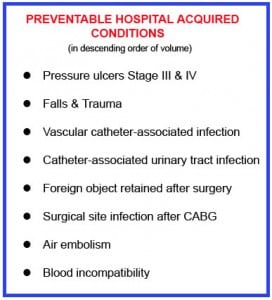Since October 1, 2008 the Centers for Medicare and Medicaid Services (CMS) classified pressure ulcers as a preventable Hospital-Acquired Condition (HAC) that will no longer be reimbursed by current insurance guidelines. In order to understand how this works, I first need to provide some definitions:
MS-DRG: Diagnosis Related Groups (DRG) is a system for classifying hospital cases into levels reflecting hospital resource utilization. MS-DRG stands for Medicare Severity Diagnosis Related Groups, an advanced version of the original DRG system which takes into account how ill the patient is. Patients who are classified as sicker, with Complicating Conditions will be reimbursed at a higher rate, EXCEPT if that condition is a designated preventable Hospital-Acquired Condition (HAC) such as a new pressure ulcer Stage III or IV (see below).
ICD-9-CM: All diseases have specific numbers that are designated for data gathering and insurance purposes. ICD-9-CM stands for International Classification of Diseases, 9th Revision, Clinical Modification, and is the official system of assigning codes to diagnoses and procedures associated with hospital utilization in the United States. There are ICD-9-CM diagnosis codes that identify Complicating Conditions that trigger higher insurance payments when they occur in the hospital.
Social Security Act 1886(d)(4)(D): This Act of Congress passed in 2005, authorized CMS to encourage prevention of hospital-acquired complications by denying enhanced reimbursement for specific conditions which satisfy the following three criteria. The goal was to create financial motivation for improving health-care quality by denying payment for potentially preventable conditions. A condition in this category is designated a preventable Hospital Acquired Condition (HAC).
1) Diseases codes with high cost, high volume, or both.
2) Disease codes which result in DRGs with higher payment.
3) Disease codes for conditions that could reasonably have been prevented through the application of evidence-based guidelines.
Why Pressure Ulcers Were Designated HAC
 CMS and the Centers for Disease Control (CDC) used Medicare data to determine conditions that were high cost, high volume, or both. They looked specifically at Complicating Conditions that would result in higher paying MS-DRG, then reviewed evidence-based guidelines to determine which conditions were “reasonably preventable.” The following table presents eight conditions classified as HAC.
CMS and the Centers for Disease Control (CDC) used Medicare data to determine conditions that were high cost, high volume, or both. They looked specifically at Complicating Conditions that would result in higher paying MS-DRG, then reviewed evidence-based guidelines to determine which conditions were “reasonably preventable.” The following table presents eight conditions classified as HAC.
The clinical practice guideline used for pressure ulcers was published in 1992, and entitled Pressure Ulcers in Adults: Prediction and Prevention. CMS found that in Fiscal Year 2007, pressure ulcers were the most common condition on the list, with 257,412 cases of hospital acquired Stage III or IV ulcers. Therefore, pressure ulcers Stage III and IV are now classified as preventable Hospital Acquired Conditions (HAC) that will no longer give hospitals added insurance reimbursement when they occur. Whether pressure ulcers are really preventable will be covered in a future blog entry, so stay tuned.
* * * * * * * * * * * * * * * *
See related post: Pressure Ulcer Regulations in the Nursing Home: Introduction to Revised F-Tag 314
The primary reference for this post is Federal Register, Volume 73, # 161, Tuesday August 19, 2008.
